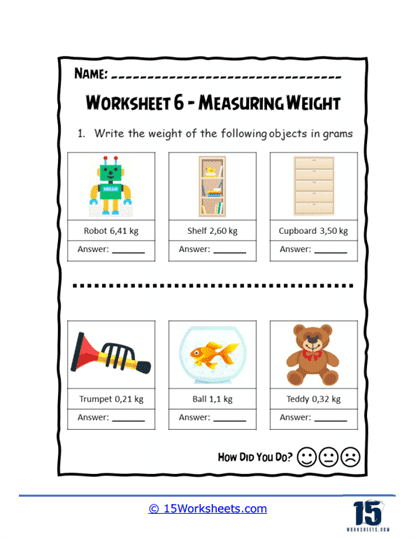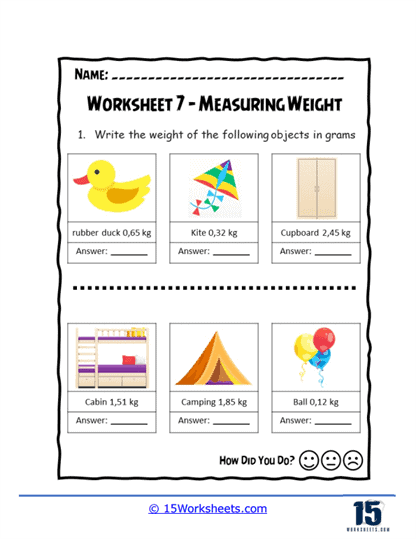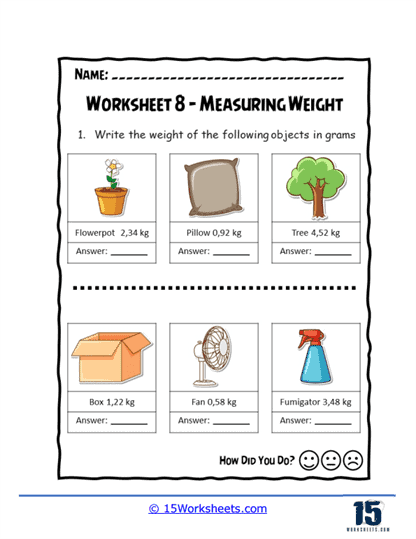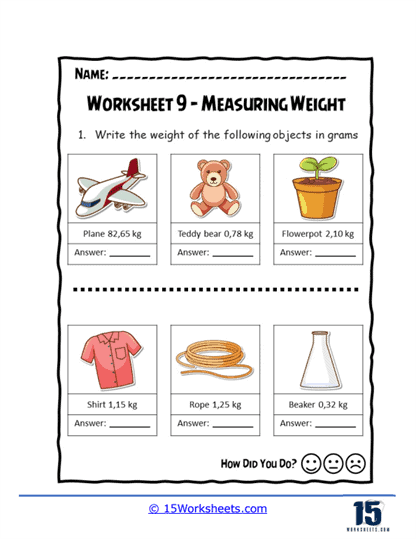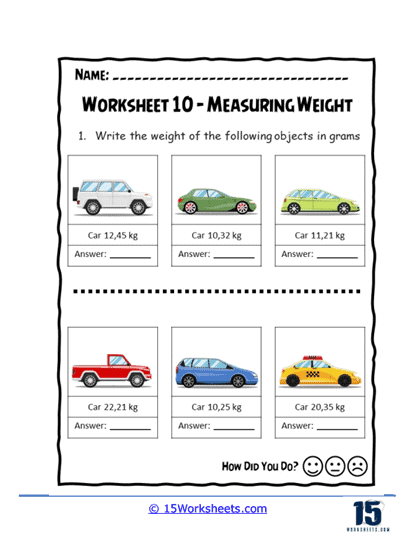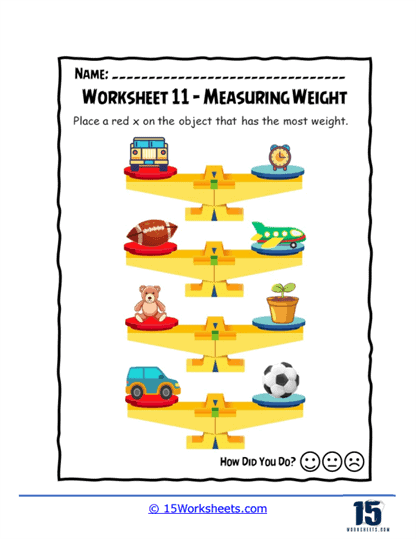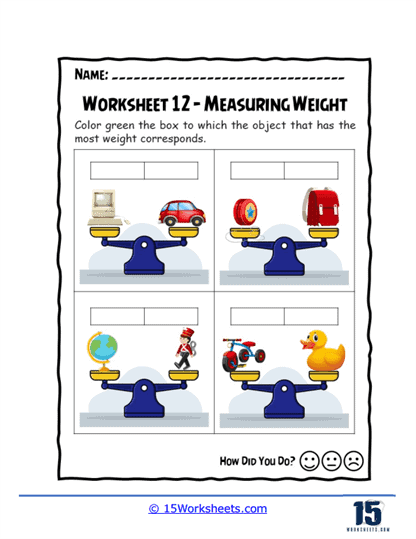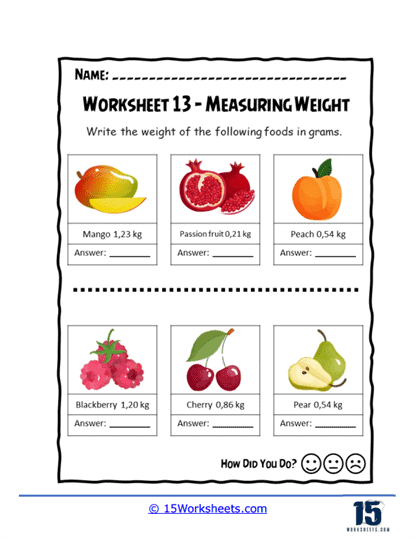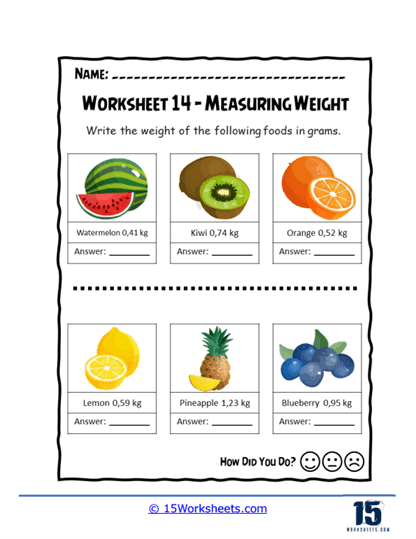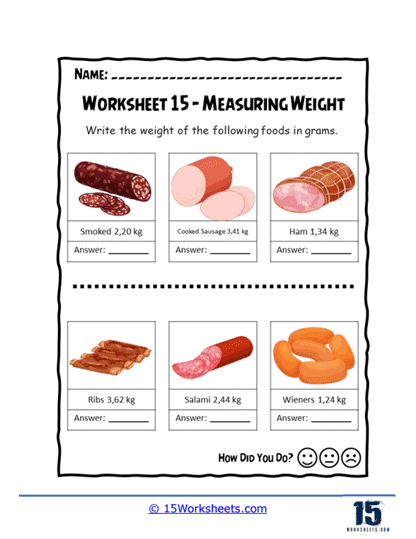Measuring Weight Worksheets
About These 15 Worksheets
These worksheets help teach and reinforce the concept of weight and mass measurement across various contexts. These worksheets are commonly used in educational environments such as schools, particularly in math and science classes, as well as in real-world applications involving cooking, manufacturing, and science experiments. The primary purpose of these worksheets is to help students understand how to measure, compare, and convert different units of weight accurately. This comprehension is crucial not only in academic settings but also in everyday life where precise measurements are essential for numerous tasks.
This collection is instrumental in teaching practical life skills and foundational mathematical concepts, making them an invaluable component of many educational curricula. Through these worksheets, students develop a robust understanding of weight and mass, preparing them for more advanced studies and practical applications in everyday life.
Types of Worksheets
Identification of Weights – One basic type of exercise found on the worksheets involves identifying objects’ weights. Students may be shown images of common items and a list of weights, and asked to match each item with its correct weight. This activity helps students become familiar with the concept of mass and begin to visualize and estimate the weight of various objects in practical terms.
Reading Scales – Another frequent exercise is teaching students how to read different types of weighing scales, such as digital scales, analog bathroom scales, or kitchen scales. Worksheets might display images of scales with the needle or digital readout in different positions, and students are tasked to write down the weight shown. This helps them familiarize themselves with how scales function and how to interpret the data they provide, which is a critical skill in many areas of life and work.
Comparing Weights – Comparative exercises are also common. Students might be given a series of weights or objects and asked to order them from lightest to heaviest. Alternatively, they might be shown pairs of items and asked to determine which item is heavier or if two items weigh the same. This type of task enhances critical thinking as students analyze and compare different weights, fostering deeper understanding and application of measurement concepts.
Weight Conversion – Conversion tasks are integral to the worksheets. Students practice converting weights between different units, such as grams to kilograms, ounces to pounds, or even between metric and imperial systems. This exercise is vital for developing flexibility in handling various measurement systems and is particularly important in contexts like cooking, where recipes might specify ingredients in different units depending on their country of origin.
Adding and Subtracting Weights – Some worksheets incorporate exercises that require students to perform calculations with weights, such as adding or subtracting different masses. This could involve practical scenarios like calculating the total weight of food items in a recipe or the combined mass of packages for shipping. These calculations help students apply their math skills in a context that emphasizes the real-world utility of arithmetic.
Estimation – Estimation exercises challenge students to guess the weight of an object and then verify their estimates using a scale. This type of exercise is excellent for developing estimation skills, which are valuable in many everyday situations where exact measurements may not be immediately possible but a reasonable approximation is necessary.
Problem Solving – More advanced Measuring Weight Worksheets might present problem-solving scenarios that involve weight. For example, students could be tasked with figuring out the correct amount of ingredients based on weight for doubling a recipe or adjusting the weight of a package to avoid excess shipping charges. These problems encourage students to think logically and apply their measurement skills in complex situations.
Some worksheets might include activities where students have to plot weight data on graphs. This could be useful in science classes where students collect data on weight and need to display this information visually. Learning to interpret and create graphs is an essential skill that aids in the analysis and presentation of data.
Interactive and Technology-Integrated Exercises – With the advancement of technology in education, some Measuring Weight Worksheets are designed to be interactive, possibly integrated into educational software or apps. These digital worksheets may use animations to simulate weighing objects, and interactive elements where students can drag and drop items onto virtual scales, providing immediate feedback and enhancing engagement.
Creative Thinking and Inquiry-Based Learning – Finally, some of the more creatively designed worksheets might involve inquiry-based learning where students are given a broader task that involves investigating weights. For example, students could conduct a project to compare the density of different materials, requiring them to calculate weight for given volumes of substances. This type of activity not only reinforces measurement skills but also integrates them with scientific inquiry, enhancing understanding and retention.
Weight Measurement Tools
Weight, often referred to as mass in scientific contexts, is a fundamental physical quantity that measures the amount of matter in an object. Several tools and instruments have been developed over time to accurately measure weight across various scales and levels of precision. Here’s an in-depth look at some of the most commonly used tools for measuring weight:
Balance Scale – One of the oldest and simplest weight measurement tools, a balance scale consists of a beam supported at its center by a fulcrum. Two pans or plates are suspended from each end of the beam. The object whose weight is to be measured is placed on one pan, while calibrated weights are added to the other until equilibrium is reached. The weight of the object is then determined by summing the calibrated weights.
Spring Scale – Also known as a dynamometer or spring balance, a spring scale measures weight by the deformation of a spring when a force is applied. The force exerted on the spring is directly proportional to the displacement of the spring from its equilibrium position. The scale is calibrated to display weight units (e.g., kilograms or pounds) corresponding to the amount of spring deformation.
Digital Scale – Digital scales utilize electronic sensors and load cells to measure weight. Load cells are transducers that convert force into an electrical signal proportional to the weight applied. The sensor detects this signal and displays the weight on a digital screen. Digital scales offer high precision and accuracy, often with features such as automatic calibration and tare function (subtracting the weight of containers).
Hydraulic Scale – Hydraulic scales use hydraulic principles to measure weight. These scales typically consist of a piston connected to a load cell. When weight is applied to the piston, it compresses a fluid (usually oil) in a closed hydraulic system. The pressure generated by the compressed fluid is then converted into an electrical signal by the load cell, providing an accurate weight measurement.
Beam Balance – Similar to a balance scale, a beam balance uses a lever system to compare the weight of an object against calibrated masses. However, instead of pans, a beam balance has a single beam with a pointer or scale attached to one end and a weight platform at the other. The object to be weighed is placed on the platform, and the position of the pointer indicates its weight relative to the calibrated scale.
Gravitational Acceleration Measurement – In scientific research and engineering applications, weight can also be measured indirectly by determining the gravitational force acting on an object. This is often done using specialized equipment such as gravimeters or accelerometers, which measure the acceleration due to gravity at a specific location. By dividing the force measured by the acceleration due to gravity, the mass (and thus weight) of the object can be calculated.
Microbalance – Microbalances are highly sensitive instruments capable of measuring extremely small masses, often to the microgram or nanogram level. They use sophisticated mechanisms such as electromagnetic force compensation or vibrating wire sensors to achieve high precision. Microbalances are commonly used in scientific research, pharmaceuticals, and nanotechnology applications where precise weight measurements are crucial.
Each of these tools has its advantages and limitations, making them suitable for different applications ranging from everyday household use to scientific research and industrial processes. The choice of the appropriate weight measurement tool depends on factors such as the required accuracy, precision, capacity, and environmental conditions.






